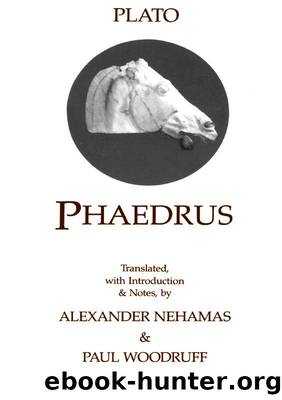Phaedrus: With a Selection of Early Greek Poems and Fragment (Hackett Classics) by Plato & Paul Woodruff & Alexander Nehamas

Author:Plato & Paul Woodruff & Alexander Nehamas [Woodruff, Paul & Nehamas, Alexander]
Language: eng
Format: epub
Publisher: Hackett Publishing
Published: 1995-03-01T05:00:00+00:00
____________________
1. Cephalus was prominent in the opening section of Platoâs Republic, which is set in his home in Piraeus, the port of Athens. He had come there from Syracuse and was successful in the manufacture of shields. His sons Lysias, Polemarchus, and Euthydemus were known for their democratic sympathies. Polemarchus, who was interested in philosophy (cf. 257b4) and is shown taking an active part in the discussion of the Republic, was killed by the Thirty Tyrants. After the restoration of democracy, Lysias (ca.459âca. 380) was given the rights of a citizen of Athens.
2. Acumenus, a relative of the doctor Eryximachus who speaks in the Symposium, was a doctor himself (Protagoras 315c; see the exchange between Phaedrus and Eryximachus in Symposium 176bâe).
3. âI take itâ: hÅs eoiken. The Greek verb is directly related to to eikos, âwhat is likely,â âwhat is plausible,â âwhat seems to be the case.â Since to eikos is the main notion to which rhetoricians such as Lysias appeal in their speeches, Platoâs use of this expression here and elsewhere in the dialogue is not accidental. We have tried to translate instances of these terms and their derivatives with expressions involving the notions of âlikenessâ and what is âlikely,â though this has not always been possible. For more discussion of to eikos, cf n. 170 below.
4. Morychus is mentioned on a number of occasions by Aristophanes for his luxurious ways.
5. Pindar, Isthmian 1.2, adapted by Plato.
6. Herodicus was a medical expert whose regimen Socrates criticizes in Republic 406aâb.
7. Socratesâ speech (228aâc) parodies the style of courtroom oratory, from his opening appeal to impossibility to his prosecution-style version of events. In the manner of Tisias (273a, below) Socrates rests his case on what is likely (eikos).
8. âHis frenzied danceâ: Socrates refers to the rites of the Corybantes, who danced themselves into an ecstatic state. Such allusions to ecstasy-producing religious practices are common in the Phaedrus. Cf. 234d (Bacchic frenzy), 241e (possession by Nymphs), 244b and 248dâe (ecstasy of the oracles), 245a and 262d (possession by the Muses), and 250bâd (the ultimate vision after initiation into a cult). Cf. the language of initiation throughout Diotimaâs speech in the Symposium.
9. A plane tree is a European sycamore or buttonwood tree.
10. According to legend, Oreithuia, daughter of the Athenian king Erechtheus, was abducted by Boreas while she was playing with Nymphs along the banks of the Ilisus River. Boreas personifies the north wind.
11. One of the demes of classical Athens.
12. âThe Hill of Ares (god of war),â located northwest of the Acropolis; it was, from very ancient times, the seat of a civic council which was itself called âAreopagus."
13. Demythologizing such accounts will not be easy: a Hippocentaur is half man, half horse; the Chimaera has a lionâs head, goatâs body, and serpentâs tail; a Gorgon was a woman with snakes for hair; and Pegasus was a winged horse. Socrates is about to invent his own such figure, the winged team and chariot driver which we meet in his second speech below.
14.
Download
This site does not store any files on its server. We only index and link to content provided by other sites. Please contact the content providers to delete copyright contents if any and email us, we'll remove relevant links or contents immediately.
| Africa | Americas |
| Arctic & Antarctica | Asia |
| Australia & Oceania | Europe |
| Middle East | Russia |
| United States | World |
| Ancient Civilizations | Military |
| Historical Study & Educational Resources |
The Daily Stoic by Holiday Ryan & Hanselman Stephen(2709)
The Fate of Rome: Climate, Disease, and the End of an Empire (The Princeton History of the Ancient World) by Kyle Harper(2436)
People of the Earth: An Introduction to World Prehistory by Dr. Brian Fagan & Nadia Durrani(2346)
Ancient Worlds by Michael Scott(2104)
Babylon's Ark by Lawrence Anthony(2070)
Foreign Devils on the Silk Road: The Search for the Lost Treasures of Central Asia by Peter Hopkirk(2056)
India's Ancient Past by R.S. Sharma(1988)
MOSES THE EGYPTIAN by Jan Assmann(1973)
The Complete Dead Sea Scrolls in English (7th Edition) (Penguin Classics) by Geza Vermes(1842)
Lost Technologies of Ancient Egypt by Christopher Dunn(1798)
The Daily Stoic by Ryan Holiday & Stephen Hanselman(1770)
The Earth Chronicles Handbook by Zecharia Sitchin(1744)
24 Hours in Ancient Rome by Philip Matyszak(1678)
Alexander the Great by Philip Freeman(1650)
Aztec by Gary Jennings(1545)
The Nine Waves of Creation by Carl Johan Calleman(1520)
Curse Tablets and Binding Spells from the Ancient World by Gager John G.;(1510)
Before Atlantis by Frank Joseph(1484)
Earthmare: The Lost Book of Wars by Cergat(1469)
